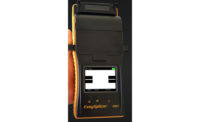Arecent groundswell in the development of coax-based Ethernet and Power over Ethernet (PoE) transceivers is providing a revolutionary opportunity for security integrators. These devices provide a simple way to upgrade and update video surveillance, access control, intercom and other system types by connecting the latest in IP-enabled devices to coax cables that were previously installed within the past 20 years. Installation professionals who learn to leverage this powerful new technology will be able to provide state-of-the-art systems for their clients at dramatically lower installation costs than those who continue to install new cabling for upgrades and the addition of new devices.
More than 30 million individual CCTV cameras have been installed in the United States since 9/11, according to market research by IMS Research. The vast majority of these are standard analog cameras connected with standard coax cables such as RG-58 and RG-59. If we add in the millions of cameras wired with coax prior to 9/11, it is safe to estimate that there are a minimum of 40 million existing coaxial cables already installed in the United States.
It is important to understand that in most cases the existing cables are installed from specific camera locations to a central point in the client’s building where the old DVR and/or video switcher is located. This centralization of the ends of the cables allows simple upgrades to newer video management software (VMS) that can be installed onto a new network server placed where the old head-end technology is located. The common maximum length of existing analog coax cables is usually 750 feet or less, which generally fits within the parameters of the common Ethernet/PoE over coax transceiver maximum cable lengths.
The True Costs of Installing New Cables
In a perfect world, security installation companies would install brand-new cables and connectors for every single device in a new or upgraded system. The reality is that the actual cost of new cable installation is the great unknown variable in every project and often spells the difference between profit and loss on a specific job.
Consider a situation in a large hotel. The client would like to upgrade their old analog cameras to high-resolution IP cameras, and add intercoms to specific doors, for example on the loading dock where an old camera is connected via coax to the hotel’s main office behind the front desk.
Let’s look at the cost to install those specific devices onto the new system. Two security integrators survey the job and provide their bids. The first integrator plans to install two all new Cat5e UTP cables from the loading dock to the hotel office, which is a distance of 600 feet. The first issue is that the 600-foot distance is further than that allowed for IP network communications within the EIA/TIA 568 standards, so some form of network switches or signal boosters will need to be installed mid-span on each run to assure proper Ethernet functionality. As the hotel has tall ceilings a lift will be needed, and it will take two technicians most of one day to install and terminate the new cables.
Here’s how the costs will be incurred when installing brand new cables:
Lift cost $400 per day
Labor 1,280 ($80/hour loaded labor cost x 16 hours)
Cable, connectors, hangers, hardware 100
UTP distance boosters ($100 x 2) 200
Total cost to run two new UTP cables $1,980
Note that the above cost estimate is just that — cost, not profits. This cost will have to be marked up by the installing dealer to achieve profitability.
The second integrator plans to utilize the existing functional coax cable along with a set of Ethernet + PoE transceivers and a PoE-enabled network switch to provide both connectivity and power for the new camera and an IP-enabled intercom.
Cost for using existing coax cable for connection to the new devices:
Ethernet + PoE transceiver set with power supply $600
PoE-enabled 8-port network switch 80
Labor 240 ($80/hour loaded labor cost x 3 hours)
Equipment cabinet, hardware, new connectors 100
Total cost when using existing coax cable $1,020
There is a 48 percent cost savings when using the existing coax cable compared with the installation of new UTP. When multiplied by the total number of devices to be updated, integrators who know how to utilize existing coax cables will have a substantial pricing advantage that will present a dramatic cost difference when the client compares the dollars for each proposal. Who gets the job when one bid is 40 percent less than another?
Security integrators should see that it is imperative they embrace this technology lest they fall victim to new-school companies who can leverage existing cables for their maximum use while minimizing installation labor costs.
Environmental Issues & Cable Installations
The pulling of new cables in existing buildings can expose installation companies to some potentially costly issues related to EPA regulations. If a cable is being installed, and a hole is punched into a wall that contains asbestos insulation, a licensed asbestos removal company must be contracted to handle the asbestos and its disposal. If this environmental problem is ignored, the building owner and/or the installation company can be fined up to $32,000 per day from the start date of the project. The same set of circumstances can occur with lead paint, which also requires licensed handling and disposal, with the risk of substantial fines if an integrator or building manager doesn’t do the right thing.
There is yet another potential pitfall for security companies when installing new cabling in existing buildings. According to the National Electric Code (NEC), unused and/or abandoned cables are supposed to be removed from buildings. It is common for some installation companies to ignore this requirement. If a fire were to occur in the building, the wiring contractors who worked on the building recently might well be brought into court and asked why they failed to remove the old cables.
For installation companies that want to adhere to these environmental and fire code requirements, existing coax cables suddenly become extremely valuable. New devices and systems can be installed using the existing coax cables without treading on legal requirements and potentially exposing the contractor to fines.
In a recent large project proposal for a regional housing authority, one manufacturer, NVT, presented its EC-1701 Ethernet + PoE transceivers to be used to facilitate the replacement of existing analog cameras with high-definition IP surveillance cameras. When considering the costs of asbestos and lead paint abatement if new cable were to be installed, using the NVT devices on the existing coax cables will save more than $250,000 in installation cost.
“These Ethernet + PoE transceivers check all three boxes of cost concerns as the issues of lead paint, asbestos, and cable removal are eliminated,” states Joe Byron, Eastern regional sales manager for NVT.
Ethernet Transmission Over Coax
Given functional cables and connectors, the bandwidth of coax cables is more than adequate to transmit 10/100 Ethernet. Most vendors’ transceiver device sets will provide 100 Mbps Ethernet data transmission. This allows for the connection of any type of IP-enabled individual physical security devices, such as megapixel or HD IP surveillance cameras, intercoms, access control panels, and alarm signal transmitters. It is important for security integrators to understand that with the addition of a network switch at the far end, multiple IP cameras and devices can be connected to the new switch via Cat5e UTP with all of the data being carried to the head-end over a single coax cable.
Some vendors provide the capability to connect multiple remote transceivers into a single transceiver at the head-end by connecting the coax cables to a splitter/combiner. In most cases the transceiver sets must come from the same manufacturer. It is unlikely that a transceiver from vendor A will communicate with another from vendor B.
Power Transmission Over Coax
One of the tremendous advantages of using existing (or new) coax for Ethernet security applications is the ability to provide standardized PoE power over the same coax that is carrying the Ethernet data. No extra cables need to be run, and in most cases, remote power supplies are not needed. This reduces initial system installation cost and decreases the potential for future power problems, as separate power supplies need not be installed at remote locations around the building.
What makes PoE over coax so powerful is that while the current PoE plus IEEE standard, 802.3at, provides a maximum of 25.5 watts of 48VDC power, coaxial cable has the potential to deliver much more than the minimum standard. Based on the type of coax and the distance, up to 45 watts of power can be transmitted over a single existing coax. With the newer IP cameras drawing less than 6 watts of total PoE power, multiple cameras or devices, including network switches, can be powered from one cable.
Using PoE over coax will centralize the power requirements for the security devices, eliminate many additional remote power supply boxes, simplify power backup, and greatly reduce servicing time and costs.
Testing Methods for Existing Coax
When considering using existing coax cables, smart integrators will perform the proper investigations and tests to determine the quality of the prospective cables to be used.
The type of cable often will be printed on the side, and a quick call to the manufacturer should provide the needed information regarding center conductor size. (See related article, “How to Identify Specific Types of Installed Coax Cables,” on page 92). Once this data is gathered, each cable should be tested for the total resistance between the shielding and the center conductor. To perform this test, place a jumper between the center pin and the outside of the existing BNC connector. Hook up a volt/ohm meter to the near end and read the resistance in ohms.
Another important test is to verify the total length of the cable to be used. A relatively inexpensive tester from the Byte Bros. is called the “Real World Certifier.” This tester can be used to determine the distance of existing coax and UTP cables when properly connected. For coax, this distance test is a single-ended event, so this test would be best accomplished from the existing head-end where the ends of the coaxes are centrally located.
Once the distance and resistance values have been verified, checking with the Ethernet over coax vendor’s specification sheet will determine how much PoE power can be passed through each cable. With this information calculated, the system can be configured so that there will be Ethernet connectivity and adequate PoE power for all devices to be connected to the existing coax cable runs. If these tests indicate that the existing cable cannot carry the needed PoE current to the far end of the coax, the addition of an inexpensive PoE multiport network switch (with its associated power pack) can provide all of the current necessary to power the remote IP-enabled PoE devices.
Replacement of Existing Connectors
When using existing coax cables every existing connector should be cut off and replaced. The center conductor of an existing coax cable with a BNC connector will oxidize over time, increasing resistance and potential conductivity problems. Old connectors should be cut off and new high-quality BNC connectors should be installed on both ends of every cable.
This is an area where trying to save a few dollars can cost a security company much more in the long run. The top-grade BNC connectors are compression-fit, as supplied by vendors such as Beldon/ICM Cable Pro. Using these connectors on the fresh conductors and shield that will be exposed when the old connector is cut off will ensure proper connectivity. Cheaper connectors might save an integrator a couple of dollars for each cable, but the service calls that result from poor connectors damage company profits and customer goodwill.
The Disruptive Technology of Using Existing Coax Cables
Before the advent of the digital communicator, all monitored alarm systems were connected to central stations via some form of direct copper wiring, usually leased or rented from the local telephone company. The cost of the leased lines limited the number of monitored systems, as many clients could not afford the high monthly cost of paying the local telco for the leased copper connections.
In the late 1970s the digital alarm signal dialer was introduced, which allowed security alarm signals to be reliably transmitted over clients’ existing telephone lines. This “disruptive” technology completely changed the alarm business, creating vast opportunities for security dealers to monitor alarm systems with no additional cost to the end user for leased telephone lines. The profit center of recurring monthly revenue (RMR) from digitally monitored accounts was born, and the alarm industry has grown substantially ever since.
The ability to reuse existing coax cables to install the latest IP-enabled physical security devices is the next “disruptive” technology to affect the electronic security industry, and will have an impact just as great as the introduction of the digital alarm communicator.
It is a simple concept that is changing the industry today. Astute security integrators are trading the unknown cost of cable installation for the known cost of coax Ethernet/PoE transceiver sets, guaranteeing profitability on each such installation. Installation companies that insist on selling systems as they have in the past will find themselves losing sales due to their higher labor costs. Security integrators who want to remain competitive must become knowledgeable about the capabilities of existing coax cables, the various transceivers and PoE power transmitters that are available, and how to sell systems that reuse cables that are already in place.
Ethernet over Coax Vendors |
|
There are a number of quality manufacturers, including those listed here, producing transceiver devices for transmitting Ethernet and PoE over existing coax cables. Please visit their websites for more information on their specific products.
Altronix
ComNet
LanPower Network Video Technology Nitek eBridge Ethernet Adaptors from Altronix make it possible to use legacy coax infrastructure with IP video surveillance and access control devices without the cost of installing new cabling. |
How to Identify Specific Types of Installed Coax Cables |
|
The basic design of most coax cables is very similar. A solid center conductor is surrounded with a non-conductive dielectric substance, with the dielectric surrounded with electrical shielding. This shielding can be a foil wrap, braided wire, or some combination of the two. The shielding can be broadly defined as dual shield, which has a foil and braid combination that provides 60 percent shielding from outside EMI and RFI. Quad shield consists two foil and braid shielding wraps and is claimed to provide 95 percent shielding. Different manufacturers have constructed specific types of coax cable using different core sizes and shielding combinations. While various types of coax “RG” (Radio Guide) cables have been produced, one measurement is consistent, that being the core diameter(s). Following is a list of the common RG cabling core sizes:
RG-11 – 1.63mm = 14 gauge Notice that RG-59 can be either 20 or 22 gauge, with the 20-gauge larger core size providing longer potential Ethernet connections and more available PoE power transmission.
Another differentiating factor in coax cables is the construction of the center core. Some coax cables have a solid copper conductor, while less expensive cables may have a center conductor made of steel with a copper coating. The typical existing coax cable will be an “RG-59” type. RG-59U typically has a solid copper center conductor while RG-59BU will usually have a steel core with a copper coating center conductor. |
Installation Contract Language |
|
If you are planning to use existing coax, fiber, or UTP cables, it is very important that security professionals include the proper language in the agreement with the end user that will protect the integrator in the event of unforeseen problems with the cables. The agreement should state that the existing cables will be used, provided that they meet accepted industry standards for performance. If a cable is found to be defective, it will be the security company’s decision whether to repair the existing cable or run a replacement. If this additional work is needed, the additional cost to the end user will be on a time-and-materials basis. This language in the agreement will protect the security installation company’s profits on the job if a cable is found to be not capable of being utilized to provide Ethernet and PoE transmissions. In a perfect world the security integrator would perform the proper testing of the coaxes to be used before the contract is finalized. However, even if the cables are tested there is always the possibility that some damage could occur to a cable or connector between the time of the contract signing and the actual start of installation. |















